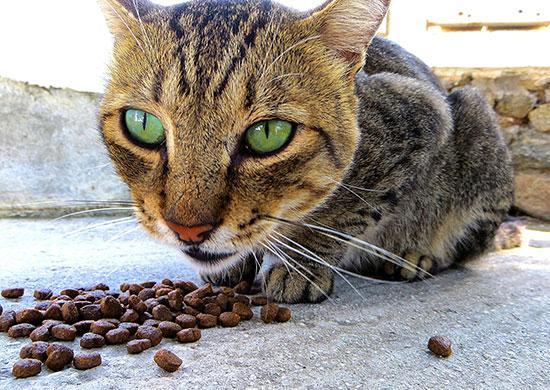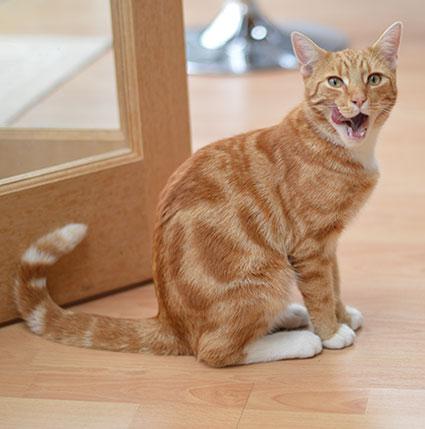This content is archived from the Feline Nutrition Foundation
Answers: What Dry Food Does to Your Cat's Appetite
- Updated: Friday, May 03, 2019 12:57 PM
- Published: Saturday, November 25, 2017 12:50 PM
- Written by Guillermo Díaz. MV
 I've been feeding my cat a vet-recommended premium dry food diet since she was eight weeks old. She is two years old now and I've noticed she's overweight and seems to not be interested in playing or exercising at all. She is also constantly hungry. I don't think that's normal. Please help!
I've been feeding my cat a vet-recommended premium dry food diet since she was eight weeks old. She is two years old now and I've noticed she's overweight and seems to not be interested in playing or exercising at all. She is also constantly hungry. I don't think that's normal. Please help!
This is a question vets get asked over and over again. It raises an important issue with regard to how suitable carbohydrates are in commercial dry cat food. As mentioned in previous articles, cats have evolved as obligate carnivores, consuming foods that are mostly water, such as small mammals, insects, birds and small reptiles. These natural foods contain mostly protein and relatively little carbohydrate or fat. To illustrate this, a mouse carcass is about three percent carbohydrate. Dry cat food? It can be up to fifty percent carbohydrates. That's far from what Mother Nature intended for cats. If a cat gets fed more carbs than she was biologically designed to metabolize, it will be stored as fat.
The selection and evolution of the feline species has made it possible for them to efficiently extract and metabolize protein for energy, even in situations where dietary protein is very limited. This selection and evolution has made cats non-dependent on carbohydrates, unlike other animals, humans included. This is the reason why cats aren't able to efficiently metabolize the excess of carbohydrates in their diet. Unlike dogs and humans, cats lack the enzymatic pathway called glucokinase, which is important for both insulin secretion and glucose uptake from the blood.¹ To make matters worse, the extrusion process used to make dry foods requires high heat and temperature which converts complex carbohydrates into simple sugars. These sugars are absorbed at a high rate right after a meal.² Nothing in the cat's evolutionary development could possibly have prepared it for this sugar-laden "junk food."
 These highly-refined and processed carbs slow down the metabolism and block many enzymatic pathways, produce inflammation and as a result contribute to diseases such as diabetes, early aging, allergies, periodontal disease, endocrine pathway shutdown and cancer. From an evolutionary perspective, the nutrients of the natural feline diet are extremely important to control the messages of genes which affect health and weight. These nutrients in their natural state lock and unlock the genes which control weight and metabolism, helping to prevent disease.
These highly-refined and processed carbs slow down the metabolism and block many enzymatic pathways, produce inflammation and as a result contribute to diseases such as diabetes, early aging, allergies, periodontal disease, endocrine pathway shutdown and cancer. From an evolutionary perspective, the nutrients of the natural feline diet are extremely important to control the messages of genes which affect health and weight. These nutrients in their natural state lock and unlock the genes which control weight and metabolism, helping to prevent disease.
The high rate at which the simple sugars from a dry kibble diet enter the cat's bloodstream is detrimental because they initiate a cascade of molecules which promote hunger and weight gain. The primary molecule responsible for this is insulin. The function of this hormone is to help sugar molecules get inside the cells. When a feral cat is eating hunted food or a pet is fed raw cat food, its body releases the very small amount of insulin necessary to metabolize the sugar content of the food. This raw food for cats would be no more than three percent carbohydrate. However, the problems begin to occur when there is too much sugar in the diet. Unlike natural raw cat food, the highly-refined carb/sugar content of dry commercial kibble will flood the cat's bloodstream and raise insulin levels to very high levels. Over time, cats become resistant to the effects of insulin and therefore will need more and more to function. This effect is called insulin resistance and has some very serious implications, a direct impact on appetite and is the pre-condition of a deleterious disease called type 2 diabetes.
Insulin resistance behaves pretty much like a drug addiction. When a person is a drug addict, they develop a tolerance and therefore will need more and more of the drug to obtain the same effect. This is the reason why cats fed dry kibble are in a constant hunger state: the natural sharp insulin feedback mechanism is totally disrupted. In the first phase, or pre-diabetes state, after a dry meal is given, large amounts of insulin hormone is still circulating in the cat's bloodstream³ in search of more carbohydrates to deal with and the cat will look for more food/sugar to ingest, entering into a vicious cycle. In the meantime, the cat is getting fatter and fatter. In later stages, a diabetes state, the pancreas will shut down because its beta cells are no longer able to produce more insulin. When a cat reaches this state the owner will have to inject the cat with doses of insulin on a daily basis.
Additional Reading
Raw Cat Food and Kibble Don't Mix
Figuring Out the Carbs in Canned Cat Food
In order for a cat to be healthy and happy, she needs to do what she normally would if she were in the wild: eat and fast. The idea of feeding dry kibble 24/7 is just insane and opposed to the biology, physiology and evolution of the cat as a species.
It's very important for owners to understand the fact that cats are obligate carnivores and feeding them inappropriate diets will be very detrimental for their health. Cats and dogs are resilient species and food-related diseases brew long before the first clinical signs appear. When those signs do appear, often it is too late to go back to a healthy state. Do not wait until that happens to change your mind and change kitty's diet to species-appropriate raw food for cats.
Note: Feline Nutrition provides feline health and nutrition information as a public service. Diagnosis and treatment of specific conditions should always be in consultation with your own veterinarian. Feline Nutrition disclaims all warranties and liability related to the veterinary advice and information provided on this site.
Dr. Guillermo Díaz and family, including their four dogs (Leroy, Xica, Moza and Pepa) and six cats (Michalina, Tigger, Vladimir, Yellow, Mongo and Chirusa) moved to Buenos Aires, Argentina in July of 2017, where he expects to continue supporting different animal rescue groups, spread the benefits of raw food for cats and dogs and write articles about nutrition.
1. AK Hewson-Hughes, MS Gilham, S Upton, A Colyer, R Butterwick and AT Miller, "Postprandial Glucose and Insulin Profiles Following a Glucose-loaded Meal in Cats and Dogs," British Journal of Nutrition 106, Sup 1, Oct 2011, 101-4.
2. AK Hewson-Hughes, MS Gilham, S Upton, A Colyer, R Butterwick and AT Miller, "The Effect of Dietary Starch Level on Postprandial Glucose and Insulin Concentrations in Cats and Dogs," British Journal of Nutrition 106, Sup 1, Oct 2011, 105-9.
3. H Farrow, JS Rand, JM Morton and G Sunvold, "Postprandial Glycaemia in Cats Fed a Moderate Carbohydrate Meal Persists for a Median of 12 Hours - Female Cats Have Higher Peak Glucose Concentrations," Journal of Feline Medical Surgery 14, no. 10, Oct 2012, 706-15.




